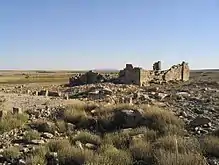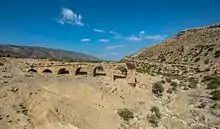Aggar (city)
Aggar was a town and bishopric (now titular) in the Roman province of Byzacena. One of two cities in the area, it left vast ruins that are now called (Henchir) Sidi Amara. These edifices are situated in the plain of Kairouan,[1][2] around 60 kilometres east of Maktar.[3]
 Ruins of Aggar | |
 Shown within Tunisia | |
| Location | Tunisia |
|---|---|
| Region | Siliana Governorate |
| Coordinates | 35°41′18.0″N 9°10′0″E |
A distinct Sidi Amara further north in Tunisia holds the ruins of the Ancient town of Avioccala, located in the Roman province of Africa Proconsularis.
Ruins

The ruins of Aggar, whose identity is confirmed by inscriptions found there, include those of a triumphal arch opening onto a large porticoed area, with a temple behind it, which must have been the forum and the capitol. A Byzantine fortress, 30 m square with square, slightly projecting corner towers was built on an arcaded structure identified as a temple of Juno. Another temple of unidentified dedication adjoins this citadel. Outside the city proper stands a two-storey mausoleum of a certain C. Marius Romanus with roofing almost intact. A ruined theatre can also be seen. About 1500 metres west of the town, the wadi Jilf was crossed by a bridge originally of ten arches, of which six remain.[1][4]
History

The town, which stood at the outlet of a rocky pass, was 16 miles from Thapsus.[5] It is mentioned in the De Bello Africo attributed to Aulus Hirtius, chapters 67 and 79.[6] Aggar appears in the Tabula Peutingeriana[7]
In AD 232, Aggar was granted the rank of municipium (CIL VIII 1, 714),[2] and later became a colonia.[4]
Ecclesiastical history
Aggar was among the many cities of sufficient importance in Roman North Africa to become a suffragan diocese of the Metropolitan of Carthage, in the papal sway, but faded, plausibly at the seventh century advent of Islam.
The only historically documented bishop of Aggar is Donatus, one of the Catholic bishops whom the Arian Vandal king Huneric summoned to a Council of Carthage in 484 and then exiled,[5] unlike their schismatical Donatist counterparts (none reported from Aggar).
Titular see
The diocese was nominally restored by the Catholic Church in 1933 as a Latin titular bishopric[8] of Aggar (Latin = Curiate Italian) / Aggaritan(us) (Latin adjective).
It has had the following incumbents, so far of the fitting Episcopal (lowest) rank:
- Joseph Ludwig Buchkremer (28 October 1961 – 24 August 1986 (death)), first as Auxiliary Bishop of Diocese of Aachen (Germany) (28 October 1961 – 4 October 1979), then as emeritate
- Alfred Kostelecky (12 November 1986 – 10 February 1990) as Auxiliary Bishop of Wien (Austria) (12 November 1986 – 10 February 1990); later Military Ordinary of Austria (Austria) (12 November 1986 – 22 February 1994), emeritate as Titular Bishop of Wiener Neustadt (10 February 1990 – 22 February 1994 (death))
- František Radkovský (17 March 1990 – 31 May 1993) as Secretary General of Czech Bishops' Conference (1990 – 7 July 1993) and Auxiliary Bishop of Archdiocese of Praha (Prague, Bohemia, Czechia) (17 March 1990 – 31 May 1993); later Bishop of Plzeň (Pilsen, Czechia) (31 May 1993 – 12 February 2016 (retired))
- Antoni Józef Długosz (18 December 1993 – ...), first as Auxiliary Bishop of Archdiocese of Częstochowa (Poland) (18 December 1993 – 7 May 2016 (retired)), then as emeritate.
See also
- List of Catholic dioceses in Tunisia
References
- M. H. Fantar, "Aggar" in Encyclopédie Berbère
- "Aggar." Hubert Cancik, Helmuth Schneider (editors), Brill’s New Pauly. Antiquity volumes (Brill Online, 2014) Retrieved 7 October 2014
- The Stages of Silence
- A. Ennabli, Aggar (Henchir Sidi Amara) Tunisia" in The Princeton Encyclopedia of Classical Sites
- Stefano Antonio Morcelli, Africa christiana, Volume I, Brescia 1816, pp. 71–72
- C. Iulii Caesaris Commentarii de bello Gallico et civili: accedunt libri De bello Alexandrino, Africano et Hispaniensi, Volume 2 (Ex Typis viduae Pomba et filiorum, 1818). pp. 135, 145
- Image of section of Tabula Peutingeriana
- Annuario Pontificio 2013 (Libreria Editrice Vaticana 2013 ISBN 978-88-209-9070-1), p. 827
Sources and external links
- Bibliography – ecclesiastical
- Pius Bonifacius Gams, Series episcoporum Ecclesiae Catholicae, Leipzig 1931, p. 464
- Stefano Antonio Morcelli, Africa christiana, Volume I, Brescia 1816, pp. 71–72
